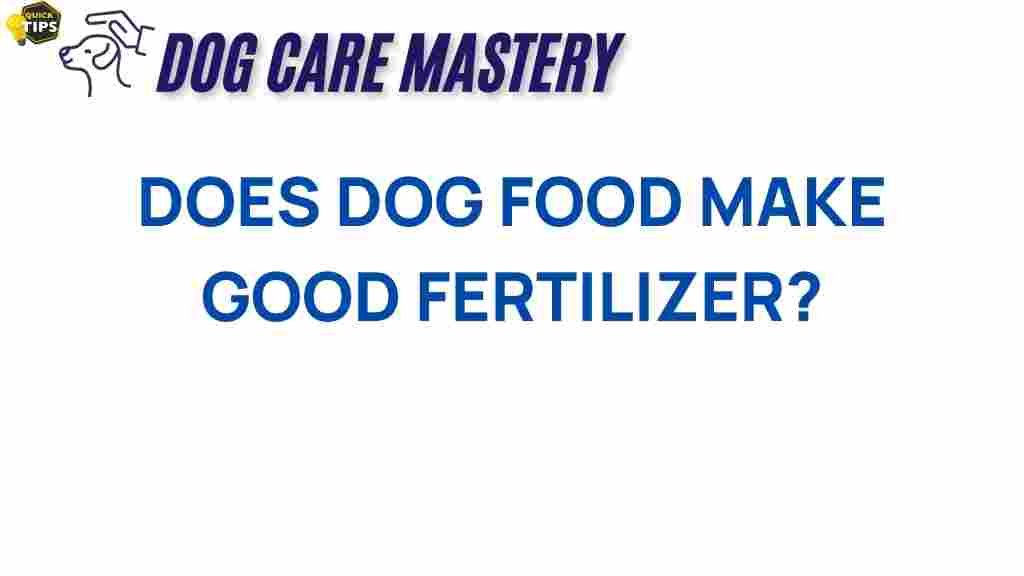Unconventional Uses: Can Dog Food Transform Your Garden Soil?
When it comes to gardening, most of us are familiar with compost, fertilizers, and soil amendments. However, the idea of using dog food as a soil enhancer may seem unconventional. Surprisingly, dog food can provide essential nutrients that can transform your garden soil and promote healthier plant growth. In this article, we’ll delve into the benefits, application methods, and tips for using dog food to improve your garden soil.
Why Consider Dog Food for Your Garden Soil?
Dog food is typically rich in proteins, fats, vitamins, and minerals. These nutrients can be beneficial for soil health and plant growth when used correctly. Here are some reasons why you might consider incorporating dog food into your gardening routine:
- Nutrient-Rich Content: Dog food often contains meat by-products, grains, and vegetables, making it a nutrient-dense option for soil enrichment.
- Cost-Effective: If you have leftover dog food that your pet doesn’t eat, instead of throwing it away, you can repurpose it in your garden.
- Organic Matter: As dog food decomposes, it adds organic matter to the soil, improving its structure and moisture retention.
- Beneficial Microorganisms: The breakdown of dog food can promote the growth of beneficial bacteria and fungi in the soil, which are essential for nutrient cycling.
Understanding the Nutritional Profile of Dog Food
Before you begin using dog food in your garden, it’s essential to understand its nutritional profile. Most dog foods contain:
- Proteins: Important for plant growth, as proteins break down into amino acids that plants utilize.
- Carbohydrates: Provide energy for soil microorganisms, which enhances soil fertility.
- Fats: While not directly useful for plants, fats can help improve soil texture when broken down.
- Vitamins and Minerals: Essential for overall plant health, promoting stronger growth and resistance to diseases.
How to Use Dog Food in Your Garden
Now that we’ve established the benefits of dog food, let’s explore how to effectively use it in your garden. Follow these steps for optimal results:
Step 1: Choose the Right Dog Food
Not all dog foods are created equal. Choose a high-quality, natural dog food without artificial additives. Look for options that are free from harmful ingredients like preservatives and fillers. Avoid using dog food that contains too much salt or chemicals, as these can harm your plants.
Step 2: Prepare Your Garden Bed
Before applying dog food, prepare your garden bed by loosening the soil. This can be done with a shovel or garden fork. Aerating the soil allows for better penetration of the nutrients from the dog food.
Step 3: Apply the Dog Food
There are a couple of methods for applying dog food to your soil:
- Top Dressing: Spread a thin layer of dry dog food on top of the soil and lightly rake it in. This method allows the nutrients to gradually seep into the soil as it rains or through watering.
- Composting: You can also add dog food to your compost pile. Mix it with other compost materials like vegetable scraps, grass clippings, and leaves. This will help balance the nitrogen-rich dog food with carbon sources.
Step 4: Water Thoroughly
After applying dog food, water your garden thoroughly. This will help dissolve the nutrients and encourage microbial activity, which is essential for breaking down the food components.
Step 5: Monitor Plant Growth
Keep an eye on your plants after applying dog food. Check for any signs of nutrient deficiency or excess. Healthy plants should show signs of robust growth and vibrant color.
Potential Issues and Troubleshooting Tips
While using dog food can be beneficial, there may be some issues to watch for. Here are some troubleshooting tips:
Over-Fertilization
Using too much dog food can lead to over-fertilization. Symptoms include:
- Leaf burn or browning
- Stunted growth
- Increased pest attraction
To remedy this, dilute the dog food application or increase the amount of water you use.
Attracting Pests
Dog food can attract unwanted pests like raccoons, rodents, or insects. To minimize this risk:
- Apply dog food in small amounts.
- Cover the soil with a thin layer of mulch to deter pests.
Odor Issues
Decomposing dog food can produce unpleasant odors. If you encounter this problem, consider:
- Mixing dog food with other compost materials to balance odors.
- Covering the application with soil or mulch.
Soil Imbalance
Excess nutrients from dog food can lead to soil imbalance. Regularly test your soil to ensure a balanced nutrient profile. This can be done using soil testing kits available at garden centers or through local agricultural extensions.
Conclusion
Using dog food in your garden may seem unconventional, but it can be a surprisingly effective way to enrich your soil. With its rich nutritional content, dog food can enhance soil structure, promote healthy plant growth, and utilize waste that would otherwise go to the landfill. However, it’s important to apply it in moderation and watch for any potential issues.
By following the steps outlined in this article, you can transform your garden soil and promote a thriving garden ecosystem. Remember, always consider the specific needs of your plants and conduct regular soil tests to maintain balance. For more gardening tips and ideas, check out our gardening resource page and learn how to make the most out of your garden!
If you’re interested in more innovative gardening techniques, be sure to visit this external resource for additional insights.
This article is in the category Nutrition and created by dogcaremastery Team
